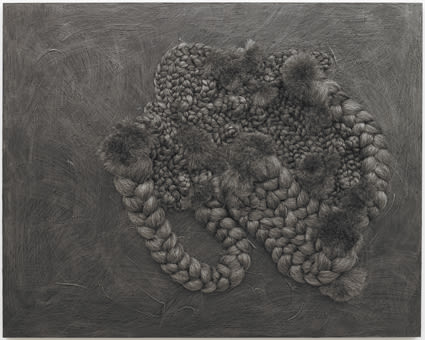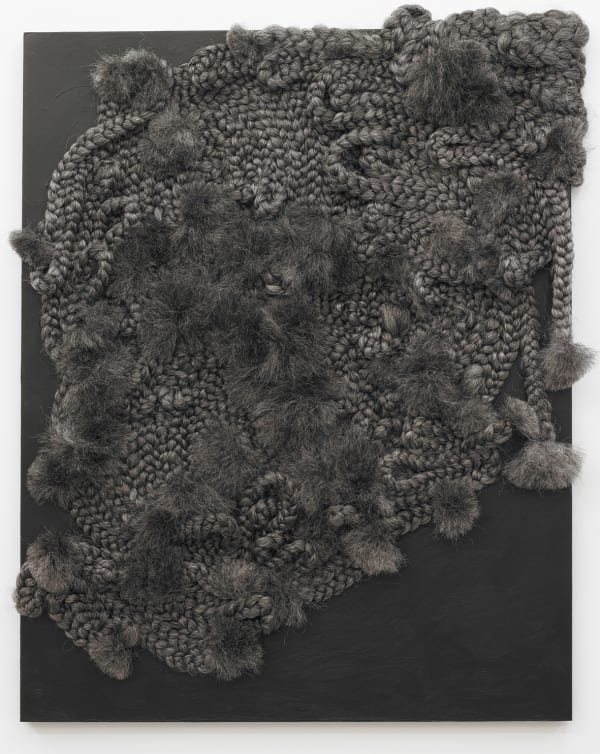HRAFNHILDUR ARNARDÓTTIR : Vanity Disorder
I am occupied with human behaviour, how the environment affects us and where we get our ideas of who and how we are as individuals. Vanity is to a different extent on the surface of my work and sometimes it appears only vaguely or in an abstract way, but it plays a role whether it is visible in the work or only in the air when I make it. […] I really respect the human need to decorate oneself and one’s environment, be it driven by vanity and obsession or sincere love for beauty, which in and of itself is vanity at its best.
(From an interview with Shoplifter in Rafskinna, No 3, 2009.)
What does Shoplifter mean with the notion of Vanity Disorder? She talks about vanity as a part of a sincere love for beauty but turns it upside down by relating it to sickness or affliction. Has she not yet recovered from the incident when she had a haircut at the age of twelve? She explains how her long hair was tied into a big braid and cut off in one piece that she still keeps in her belongings. Today, she hangs hair all over the place and braids miles and miles, creating arrangements that she seals within great vitrines. This certainly implies some kind of a disorder. The childhood shock of losing her hair may have contributed to this – the radical change of appearance and identity in the midst of puberty – but she again became fascinated with braids, coming across flowers made of hair, when she was working in an antique shop. The tradition dates back many centuries; cutting a lock of hair from a loved one who has passed away and turning it into a little flower as a memory. The idea to save the memory of an individual in an abstract decoration made of that person’s physical remains intrigued Shoplifter. No wonder that a special coffin carpenter was asked to produce the massive glass frames around the bas-relieves in the exhibition. The two self-portraits, however, are open and unframed, made of black and grey braids in style with the artist’s “salt & pepper” hair. It should be mentioned that these works, as the other braided works, are made of artificial hair. The mural, from where the exhibition draws its name, Vanity Disorder, is made of real human hair (from living donors), produced and died for hairdressers, who use it for hair extensions.
The vanity that Shoplilfter refers to is not only rooted in appearance, for there are many ways to express our idea of who and how we are as individuals. Within the notion of self-expressive art and under the shelter of modernist ideology, the artist’s vanity has flourished by revealing the unique individual behind the work. Shoplifter persistently draws from the history of the abstract tradition where men, for the most part, have found a vent for the vain longing to display their inner being. She adds a twist to the tradition with her feminine reference to fashion, design and décor where personal brush strokes are replaced by dallying and handicraft. Even though she has used a range of mixed media in her work, Shoplifter’s background is in the study of painting. She refers to the twentieth century history and traditions of the mediums of painting and drawing, like expressionism, geometry and minimalism. Extending and mounting the hair in sharp lines, she creates a geometric drawing that runs between the walls and floors of the gallery space and moulding the material into corkscrew shapes she make up flowing and expressive images. Different coloured hair is mixed and tied together like a painter works with colour on canvas. The smaller drawings on paper function as another layer within the same particular world. Shoplifter focuses on the minuscule as if it were a tiny fragment of the larger woks. She examines how threads are woven together creating a whole and how different variations can be found within one and the same colour. It is like an investigation into the molecular structure of a single hair or one cell. Perhaps a search for the vanity gene, in order to be better capable of treating the diagnosed disorder?
For the first time in a long time, the Icelandic artist, Hrafnhildur Arnardóttir, has a solo exhibition in Reykjavik. She lives in New York where she is also known under the name Shoplifter. Attempting to introduce herself abroad, she discovered that people often mistook her first name, Hrafnhildur, for Shoplifter and it got attached to her. Last time Shoplifter exhibited in Iceland was in group shows in the Reykjavik Art Museum in 2006 and in 2008. Her work has been widely on display recently in her hometown, New York. Collaborating with the composer Nico Muhly she did a project in The Kitchen in 2008, took part in the group show It’s Not Your Fault in the Luhring Augustine Gallery in same year, and there is currently a work by her and Assume Vivid Astro Focus on display at the MoMA.
Shoplifter’s exhibition at the i8 Gallery is part of the Reykjavik Arts Festival and is curated by Markús T. Andrésson.







